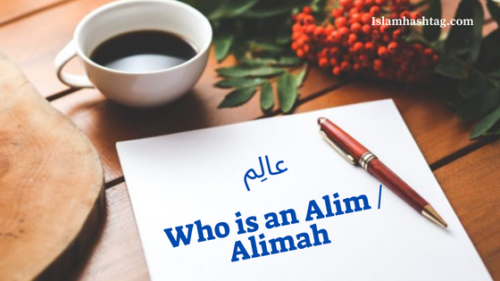Who is an Alimah or an Alim ?
An Alim/ Alimah is an Islamic Scholar who has the Ijaazah which means that every Alim is part of an unbroken chain of transmission going back to our beloved Prophet Muhammad Sallallahu ‘Alayhi Wasallam. Subhan Allah!

Definition of Alimah, Alim
Alim/ Alimah is derived from the word ‘ilm. Alim Literally means “those who have knowledge” or “those who know” (singular ˓alim, plural ˓ulama˒). The term is most widely used to refer to the scholarly class of Muslim societies, whose main occupation is the study of the texts that make up the Islamic Tradition
About Alim Course
An Alim course includes learning the translation and commentary of the entire Qur’an, Commentary of the entire Qur’an, Hadith, Islamic Law (Fiqh), Principles of Legal Methodology (Usul al-Fiqh), Beliefs (Aqeedah), Seerah, Shamail, Contemporary Issues, and Islamic Spirituality.

What is the other name of ulema?
Alternative Titles: ʿālim, ulama, ulema. ʿulamāʾ, also spelled ulema, the learned of Islam, those who possess the quality of ʿilm, “learning,” in its widest sense.
In Islam, the ulama (/ˈuːləˌmɑː/; Arabic: علماء ʿUlamāʾ, singular عالِم ʿĀlim, “scholar”, literally “the learned ones”,also spelled ulema; feminine: alimah [singular] and aalimath [plural]) are the guardians, transmitters, and interpreters of religious knowledge in Islam, including Islamic doctrine and law.
Duration of study of an Alim / Alimah course
It is 5- 6 year study of traditional Islamic Sacred science equivalent to Masters in divinity. Read Dua for studying
Prospect of studying Alim/ Alimah course
An Alim or Alimah has a deep knowledge of deen from authentic sources so it increases the spirituality of an individual and connects him/her to a connected chain to Rasul Allah Sallalahu alaihe wa sallam.
مَنْ سَلَكَ طَرِيقًا يَلْتَمِسُ فِيهِ عِلْمًا سَهَّلَ اللهُ لَهُ بِهِ طَرِيقًا إِلَى الْجَنَّةِ
“He who treads the path in search of knowledge, Allah would make that path easy, leading to Paradise for him.”
(Sahih Muslim 2699)
Male Scholars can serve the community by working as Mufti or Aalim, and female scholars can serve as Alimah as an Islamic or Arabic teachers at Islamic institutions.
Dawra Hadith of Alim Classes
In many Islamic seminaries (Dār al-ʿUlūms) of the Indian subcontinent and in those with roots there, the final year of studies – often referred to as the “dawrat al-ḥadīth” – entails studying the famous six canonical books of ḥadīth (al-ṣiḥāḥ al-sitta or al-kutub al-sitta). The dawrat al-ḥadīth is an intensive study of the major ḥadīth collections, in which students study ḥadīth texts with commentary, exploring the most prominent scholastic interpretations of the ḥadīths – in terms of their linguistic, theological, spiritual and juristic implications. All six books are read from cover to cover, after which students receive their certificate of graduation.
The ḥadīth lessons delivered by the teachers are unique and comprehensive, touching on all dimensions of an ḥadīth text: its commentary, jurisprudence, differences between the various fiqh schools, narrator criticism and so on. It has been a long-standing tradition of students to record and transcribe the lectures of their teachers, often resulting in their publication. Countless scholarly works have been produced thus far, both in Arabic and Urdu, and proved to be of immense benefit for students, researchers, scholars and teachers alike
Ilm studied by an Alim :
1. Ilm –Ul-Sarf
2. Ilm-Ul-Nahw
3. Ilm-Ul-Adab
4. Ilm-Ul-Balaghat
5. Ilm-Ul-Mantiq
6. Ilm-U-Usool-Lil-Fiqh
7. Ilm-Ul-Fiqh
8. Ilm-Ul-Falsafa
9. Ilm-E-Usool-Al-Hadith
10. Ilm-Ul-Hadees
11. Ilm-U-Usool-Lil-Tafseer
12. Ilm-Ul-Tafseer
13. Ilm-Ul-Kalam
May Allah bless all the Scholars of Isam.
Let us also look at How the the first School of
Chain of Credentials of Ulama-e-Deoband
In connection with the great ones of Darul Uloom the personality who tops the list is the same Shah Waliullah Dehelwi. Almost all the systems of the religious sciences in general and of the science of Hadith in particular that are current and extant in the sub-continent have originated from him.
Whatever zest for theological sciences that exists from Peshawar to Ras Kumari is due to the grace of this hose hold. It is the statement of a non-Indian religious divine that during his tour of India he did not meet any scholar of the science of Hadith who was not a disciple of Hadhrat Shah Waliullah through the medium of Hadhrat Shah Abdul Aziz.
Shah Sahib’s family, by virtue of its knowledge and learning, abstinence and piety, was considered very distinguished in Delhi. His father, Shah Abdur Raheem was one of the compilers of the Fatawa Alamgiri. As already stated in the foregone, he acquired knowledge from his father. At the age of 15 he had completed the course of the current sciences. Shah Sahib’s chain of authority, through his august father, reaches back to Allamah Jalaluddin Muhaqqiq Dawwani (d. 928/1521). In those days the element of rationalistic sciences was dominant in the syllabi in India.
Hence to complete the study of the science of Hadith and to obtain the Sanad of authority Shah Sahib undertook a journey to the holy cities (Mecca and Madina), and there he acquired the Sanad for the correct recitation of the Sihah and narration of Hadith from Shaikh Abu Tahir Madani and other illustrious Shaikhs. As regards Shah Sahib’s inherent geist and capability, his teacher of Hadith, Shaikh Abu Tahir Madani’s statement has been quoted supra that “Waliullah obtains the Sanad for the wordings of narration from me while I correct (my understanding of) the meanings of Hadiths through him”.
It was that period when the science of Hadith was passing through the last stage of enervation and deterioration. To propagate and to make current the science, of Hadith in such a predicament is indeed a stupendous achievement of Shah Sahib which, a glorious divine of Egypt. Syed Rasheed Reza, had to acknowledge in the following words:
“If the attention of our Indian divines had not been lavished on the science of Hadith in that period, then this science would have faded out of existence from the eastern countries, because from the 10th to the beginning of the 14th century Hijri, this science had reached the lost stage of decoy in Egypt, Syria, Iraq and Hejaz.”
Then, describing the condition of Egypt, he has stated:
“When I migrated to Egypt in 1315/1897, 1 saw the khatibs of Jamai Azhar and other mosques that they recite in their khutbas (sermons) such Hadiths, which are nowhere to be found in the tomes of Hadith. Among those Hadiths (which they recite) there are ‘weak’, ‘disavowed’ (Munkar), fabricated and counterfeit Hadiths also. The same was the condition of the preachers, muftis and teachers”.
Shah Sahib’s educational services are not continued to teaching only; he rather wrote such glorious books in different sciences the examples whereof are rarely found after the 8th century Hijri. Besides this, of Shah Sahib’s academic life there are many more momentous achievements; to mention them here even briefly is not easy, for it is a separate topic.
Shah Sahib had four sons each one of whom was a bright star in the firmament of knowledge. The eldest amongst them was Shah Abdul Aziz.
HADHRAT SHAH ABDUL AZIZ
Hadhrat Shah Abdul Aziz (1159/1746–1239/1823) was the most erudite and glorious divine of his time. The dissemination of the sciences of the Quran and the Hadith that took place in his time of course, through him has had no precedent in the annals of Islamic India.
There is no nook and corner in India where Shah Abdul Aziz disciples may not be found. The statement of a non-Indian scholar has already been quoted above that during his travels in India he did not meet any scholar of Hadith who was not a disciple of Shah Sahib. Maulana Ubaydullah Sindhi is of the view that if ten persons benefited from the great qualities of Shah Waliullah, from Shah Abdul Aziz’s qualities must have benefited at least ten thousand persons.
In short Hadhrat Shah Abdul Aziz brought the foundation Hadhrat Shah Waliullah had laid for the renaissance of the religious sciences to consummation. He established such a standard of knowledge whereby the religious sciences came to attain a special honor and dignity.
Shah AbduI Aziz, after the death at his august father, served the cause of the religious sciences in Delhi for a long period of sixty years. Besides teaching, he wrote several books amongst which his Tafsir-e Fathul Aziz, a commentary on the Quran, Bustanul Muhaddithin, on the history of the classes of traditionists and their compilations, and the Tuhfa Ithna Ashriya on the reality of Shiaism; are really very famous. The last-named book is such an opus magnum of Shah Sahib that there exists no example thereof on this topic in the entire Islamic literature.
HADHRAT SHAH MUHAMMAD ISHAQ
Hadhrat Shah Muhammad Ishaq was Hadhrat Shah Abdul Aziz’s grandson (daughter’s son) and a distinguished pupil. In the presence of Shah Abdul Aziz he taught Hadith to the students for twenty years. In 1239-1823, Shah Abdul Aziz, entrusting Madrasah Rahimia before his death to Shah Muhammad Ishaq, appointed him as his successor. Till 1257/1841 he rendered the service of disseminating and propagating the science of Hadith.
Almost the whole of India benefited from his educational graces. He translated the Mishkatul Masabeeh into Urdu, which, at his instance, was transformed into a commentary by his well-guided pupil, Maulana Qutubuddin Khan, and is known as Mazahir-e Haq, Mi’at Masa’iI and Rasa’il-e Arba’een are also his noteworthy works. Emigrating from India in 1257/1841 to Mecca, he settled down there and died after a few years.
It is stated in Tarjuma Tazkira Ulema-e Hind: “It is particularly notable that during the freedom fight of 1857 most of the pupils of Shah Muhammad Ishaq Dehelwi took part as Ulema in this movement, the most noteworthy amongst them being Mufti Inayat Ahmed Kakorwi (Sadar Amin, Bareilly), Maulana Abdul Jalil Ko’ili (Aligarhi), Mufti Sadaruddin Azurda, Shah Abu Saeed Mujaddidi (father of Shah Abdul Ghani Mujaddidi) and the pupils of their pupils, i.e.” the Ulema of Deoband, e.g., Maulana Muhammad Qasim Nanautawi, Maulana Rasheed Ahmed Gangohi, Maulana Muhammad Mazhar Nanautawi, Maulana Muhammad Munir Nanautawi etc.
Discover more from Islam Hashtag
Subscribe to get the latest posts sent to your email.




